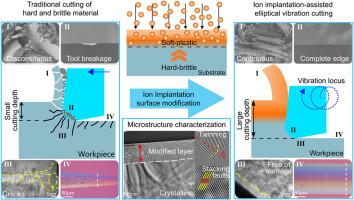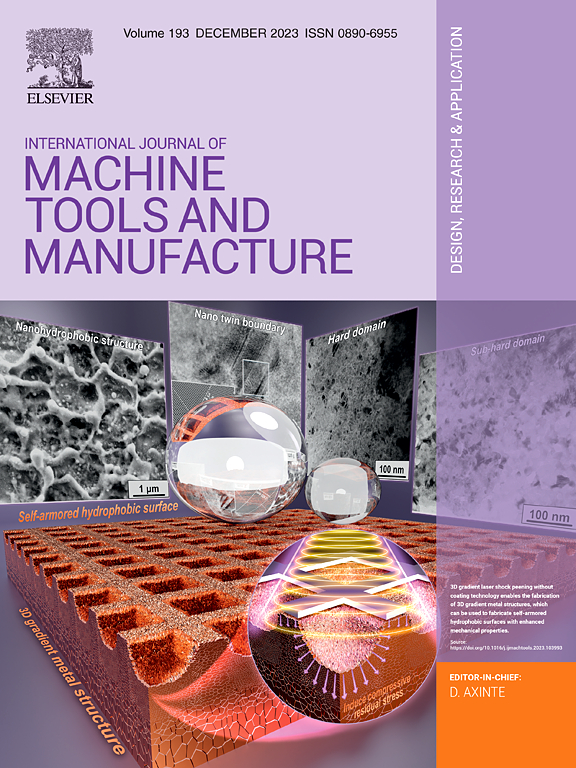离子注入辅助椭圆振动切割硬脆材料的材料去除机理研究
IF 18.8
1区 工程技术
Q1 ENGINEERING, MANUFACTURING
International Journal of Machine Tools & Manufacture
Pub Date : 2024-10-03
DOI:10.1016/j.ijmachtools.2024.104220
引用次数: 0
摘要
通过将切削深度设定为小于韧性-脆性过渡深度(DBTD),韧性-韧性加工已被用于加工硬脆材料的无损表面。然而,由于蓝宝石的硬度极高、DBTD 较小、表面断裂严重以及刀具磨损严重,蓝宝石的韧性-韧性切削仍然具有挑战性。为解决这一问题,本研究提出了离子注入辅助椭圆振动切割(Ii-EVC)技术,以提高硬脆材料的加工性能。以蓝宝石为例,将高能磷离子植入工件以改变其表面。纳米压痕测试表明,由于硬度和模量的降低,改性材料更容易发生塑性和弹性变形。与没有植入辅助的纳米切割相比,植入蓝宝石的 DBTD 增加了五倍以上。Ii-EVC 的优势效应大大提高了加工性能,包括抑制表面断裂、减少刀具磨损、切屑形态从不连续性转变为连续性以及降低切削力。此外,即使在 Ii-EVC 后脆性区域的裂纹附近,表层下的微观结构也显示出更完整的晶格排列和接近零的应变分布,表明裂纹扩展得到了有效抑制。由于促进了局部塑性变形,植入材料的应力分布远小于原始工件。植入引起的缺陷不仅可以作为吸收高频振动外部能量和改善晶粒内部变形的核心,还能促进剪切带的形成。改性层与基体之间的高畸变界面可有效耗散应变能,阻碍裂纹向自由表面扩展。车削实验验证了 Ii-EVC 可以获得更好的表面质量、更少的刀具磨损和更高的光学透射率。总之,Ii-EVC 解决了传统 EVC 中刀具与工件高频碰撞导致的刀具破损和表面断裂难题,克服了离子注入中改性深度有限的问题,并将极硬极脆材料的韧性--定常去除深度提高到几微米。这些研究结果表明,Ii-EVC 是一种很有前途的先进材料超精密制造方法。本文章由计算机程序翻译,如有差异,请以英文原文为准。

Investigation on the material removal mechanism in ion implantation-assisted elliptical vibration cutting of hard and brittle material
Ductile-regime machining has been used to generate damage-free surface of hard and brittle materials by setting the cutting depth to be smaller than the ductile-brittle transition depth (DBTD). However, the ductile-regime cutting of sapphire remains challenging owing to its extreme hardness, small DBTD, serious surface fractures, and severe tool wear. To solve this problem, ion implantation-assisted elliptical vibration cutting (Ii-EVC) has been proposed in this study to enhance the machinability of hard and brittle materials. Taking sapphire as an example, high-energy phosphorus ions were implanted into the workpiece to modify its surface. Nanoindentation tests revealed that the modified materials undergo plastic and elastic deformation more easily due to the decrease in hardness and modulus. Compared with nanocutting without implantation assistance, the DBTD of implanted sapphire has been increased by more than five times. The advantageous effects of Ii-EVC achieve great enhancement in machinability, including surface fractures suppression, tool-wear reduction, chips morphology transformation from discontinuous to continuous, and cutting force decrease. Furthermore, even near the cracks in the brittle region after Ii-EVC, the subsurface microstructure showed a more complete lattice arrangement and a strain distribution close to zero, indicating that crack propagation was effectively suppressed. Due to the promoted localized plastic deformation, the stress distribution in the implanted material is much smaller than that in pristine workpiece. Implantation-induced defects not only serve as a core for absorbing external energy from the high-frequency vibration and improving the in-grain deformation but also facilitate the formation of shear bands. The interface with high distortion between the modified layer and substrate can effectively dissipate strain energy and hinder crack propagation to the free surface. The turning experiments verified that Ii-EVC can achieve better surface quality, less tool wear and higher optical transmittance. Overall, Ii-EVC addresses the challenges of tool breakage and surface fracture caused by high-frequency collision between tool and workpiece in traditional EVC, overcomes the problem of limited modification depth in ion implantation, and increases the ductile-regime removal depth of extremely hard and brittle materials to several microns. Such findings demonstrate that Ii-EVC is a promising method for the ultra-precision manufacturing of advanced materials.
求助全文
通过发布文献求助,成功后即可免费获取论文全文。
去求助
来源期刊
CiteScore
25.70
自引率
10.00%
发文量
66
审稿时长
18 days
期刊介绍:
The International Journal of Machine Tools and Manufacture is dedicated to advancing scientific comprehension of the fundamental mechanics involved in processes and machines utilized in the manufacturing of engineering components. While the primary focus is on metals, the journal also explores applications in composites, ceramics, and other structural or functional materials. The coverage includes a diverse range of topics:
- Essential mechanics of processes involving material removal, accretion, and deformation, encompassing solid, semi-solid, or particulate forms.
- Significant scientific advancements in existing or new processes and machines.
- In-depth characterization of workpiece materials (structure/surfaces) through advanced techniques (e.g., SEM, EDS, TEM, EBSD, AES, Raman spectroscopy) to unveil new phenomenological aspects governing manufacturing processes.
- Tool design, utilization, and comprehensive studies of failure mechanisms.
- Innovative concepts of machine tools, fixtures, and tool holders supported by modeling and demonstrations relevant to manufacturing processes within the journal's scope.
- Novel scientific contributions exploring interactions between the machine tool, control system, software design, and processes.
- Studies elucidating specific mechanisms governing niche processes (e.g., ultra-high precision, nano/atomic level manufacturing with either mechanical or non-mechanical "tools").
- Innovative approaches, underpinned by thorough scientific analysis, addressing emerging or breakthrough processes (e.g., bio-inspired manufacturing) and/or applications (e.g., ultra-high precision optics).

 求助内容:
求助内容: 应助结果提醒方式:
应助结果提醒方式:


